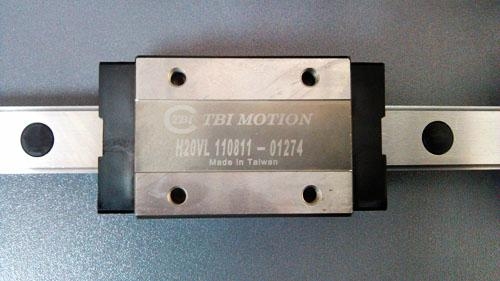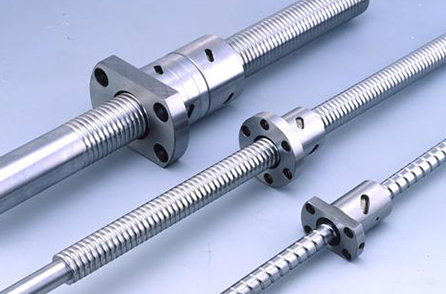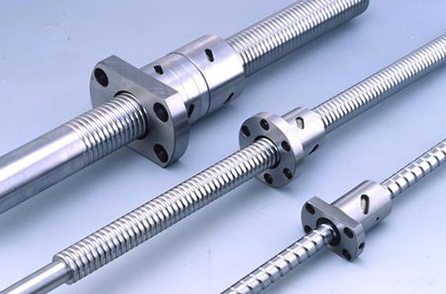丝杠动态刚度怎么检测呢?
来源:http://www.jngongrun.com/ 日期:2025-07-14 发布人:
丝杠动态刚度的测量是评估其在动态载荷下抵抗变形能力的关键环节,需通过设备和规范流程操作,以获取准确数据。以下是具体的测量方法与步骤。
The measurement of the dynamic stiffness of a screw is a key step in evaluating its ability to resist deformation under dynamic loads, and requires the use of professional equipment and standardized procedures to obtain accurate data. The following are specific measurement methods and steps.
测量前的准备工作需充分到位。需明确丝杠的型号、规格及使用工况,如公称直径、导程、工作转速等,根据这些参数选择适配的测量设备,常用的有动态刚度测试系统、激振器、力传感器、位移传感器等。检查设备的校准状态,确保传感器的精度(力传感器误差不超过 ±1%,位移传感器分辨率不低于 0.1μm)和测试系统的稳定性符合要求。将丝杠安装在专用测试平台上,模拟实际工作时的支撑方式(如两端固定、一端固定一端游动),安装时需保证丝杠轴线与测试平台平行,避免因安装偏差引入测量误差。同时清理丝杠表面的油污、杂质,检查丝杠螺母的配合间隙,确保运动顺畅无卡滞,必要时添加适量润滑油减少摩擦影响。
The preparation work before measurement needs to be fully in place. Firstly, it is necessary to clarify the model, specifications, and operating conditions of the screw, such as nominal diameter, lead, and working speed. Based on these parameters, suitable measuring equipment should be selected, including dynamic stiffness testing systems, exciters, force sensors, displacement sensors, etc. Check the calibration status of the equipment to ensure that the accuracy of the sensors (force sensor error not exceeding ± 1%, displacement sensor resolution not less than 0.1 μ m) and the stability of the testing system meet the requirements. Install the lead screw on a dedicated testing platform and simulate the actual support method during operation (such as fixing both ends, fixing one end, and moving one end). During installation, ensure that the axis of the lead screw is parallel to the testing platform to avoid measurement errors caused by installation deviations. At the same time, clean the oil and impurities on the surface of the screw, check the fit clearance of the screw nut, ensure smooth movement without jamming, and add an appropriate amount of lubricating oil if necessary to reduce friction effects.
激振与信号采集是核心环节。采用激振器对丝杠施加动态激励,激振点通常选择在丝杠中部或螺母上,激励方式可采用正弦扫频或随机激励,扫频范围需覆盖丝杠的工作转速对应的频率范围,确保包含共振频率点。力传感器安装在激振器与丝杠之间,用于采集激振力信号;位移传感器(如激光位移计、电涡流传感器)则安装在靠近激振点的位置,采集丝杠在动态激励下的位移响应信号,传感器需与丝杠表面保持垂直,避免角度偏差导致的测量值失真。测试系统需同步采集力信号和位移信号,采样频率应设置为激励频率的 5-10 倍,以保证信号的完整性。
Excitation and signal acquisition are the core components. Dynamic excitation is applied to the screw using an exciter, with the excitation point usually selected in the middle of the screw or on the nut. The excitation method can be sine sweep frequency or random excitation, and the sweep frequency range should cover the frequency range corresponding to the working speed of the screw to ensure the inclusion of resonance frequency points. The force sensor is installed between the exciter and the screw to collect the excitation force signal; Displacement sensors (such as laser displacement sensors and eddy current sensors) are installed near the excitation point to collect displacement response signals of the screw under dynamic excitation. The sensor needs to be perpendicular to the surface of the screw to avoid measurement distortion caused by angular deviation. The testing system needs to synchronously collect force signals and displacement signals, and the sampling frequency should be set to 5-10 times the highest excitation frequency to ensure signal integrity.

数据处理与分析需遵循方法。通过测试系统的数据分析软件,对采集到的力和位移信号进行处理,计算出丝杠在不同频率下的动态刚度值(动态刚度 = 激振力幅值 / 位移响应幅值)。绘制动态刚度随频率变化的曲线,曲线中出现的低谷对应丝杠的共振频率,此频率下的动态刚度,是评估丝杠动态性能的关键指标。分析曲线时需关注工作频率范围内的动态刚度变化趋势,若在常用转速对应的频率下刚度值过低,说明丝杠在该工况下易产生较大变形,可能影响传动精度。同时需多次重复测量(通常 3-5 次),取平均值作为终结果,减少随机误差的影响。
Data processing and analysis must follow professional methods. By using the data analysis software of the testing system, the collected force and displacement signals are processed to calculate the dynamic stiffness values of the screw at different frequencies (dynamic stiffness=excitation force amplitude/displacement response amplitude). Draw a curve of dynamic stiffness as a function of frequency, where the troughs in the curve correspond to the resonance frequency of the screw. The lowest dynamic stiffness occurs at this frequency, which is a key indicator for evaluating the dynamic performance of the screw. When analyzing the curve, attention should be paid to the dynamic stiffness variation trend within the working frequency range. If the stiffness value is too low at the frequency corresponding to the commonly used speed, it indicates that the screw is prone to significant deformation under this working condition, which may affect the transmission accuracy. Simultaneously, multiple repeated measurements (usually 3-5 times) are required, and the average value is taken as the final result to reduce the impact of random errors.
测量过程中的操作要点需严格把控。激振力的大小需合理设定,既要保证信号的信噪比,又不能超过丝杠的承载极限,避免因过载导致丝杠变形。测试环境需保持稳定,避免外界振动(如地面振动、设备运行振动)和电磁干扰(如电机、变频器产生的电磁场)影响传感器信号,必要时可搭建隔振平台或对传感器线缆进行屏蔽处理。对于长丝杠,需考虑其自重引起的弯曲变形对测量的影响,可在测试前进行预加载,抵消部分自重变形。此外,测量时需记录环境温度、湿度等参数,因为温度变化可能导致丝杠热胀冷缩,影响其刚度特性,后续分析时可作为参考因素。
The key points of operation during the measurement process need to be strictly controlled. The magnitude of the excitation force should be set reasonably, ensuring the signal-to-noise ratio of the signal while not exceeding the bearing limit of the screw, to avoid permanent deformation of the screw due to overload. The testing environment should be kept stable to avoid external vibrations (such as ground vibrations, equipment operation vibrations) and electromagnetic interference (such as electromagnetic fields generated by motors and frequency converters) affecting sensor signals. If necessary, an isolation platform can be built or sensor cables can be shielded. For long filament bars, it is necessary to consider the impact of bending deformation caused by their own weight on measurement. Preloading can be performed before testing to offset some of the self weight deformation. In addition, it is necessary to record environmental parameters such as temperature and humidity during measurement, as temperature changes may cause thermal expansion and contraction of the screw, affecting its stiffness characteristics, which can be used as reference factors for subsequent analysis.
动态刚度的评估需结合实际应用场景。根据测量结果,对比设计要求或行业标准,判断丝杠的动态性能是否达标。若用于精密机床进给系统,需确保在工作频率范围内动态刚度稳定且足够高,以保证加工精度;若用于普通传动机构,可适当放宽要求,但需避免共振频率落入常用工作频率区间。对于测量中发现的刚度异常(如某一频率段刚度骤降),需排查是否由丝杠本身缺陷(如螺纹精度不足、材料不均匀)或测试系统故障引起,必要时更换丝杠样本重新测量验证。
The evaluation of dynamic stiffness needs to be combined with practical application scenarios. Based on the measurement results, compare the design requirements or industry standards to determine whether the dynamic performance of the screw meets the standards. If used in precision machine tool feed systems, it is necessary to ensure stable and sufficiently high dynamic stiffness within the operating frequency range to ensure machining accuracy; If used for ordinary transmission mechanisms, the requirements can be appropriately relaxed, but it is necessary to avoid resonance frequencies falling into the commonly used operating frequency range. For stiffness anomalies found during measurement (such as a sudden drop in stiffness in a certain frequency range), it is necessary to investigate whether they are caused by defects in the lead screw itself (such as insufficient thread accuracy, uneven material) or testing system failures. If necessary, replace the lead screw sample and re measure and verify.
本文由导轨丝杠友情奉献.更多有关的知识请点击:http://www.jngongrun.com真诚的态度.为您提供为的服务.更多有关的知识我们将会陆续向大家奉献.敬请期待.
This article is a friendly contribution from the guide screw For more information, please click: http://www.jngongrun.com Sincere attitude To provide you with comprehensive services We will gradually contribute more relevant knowledge to everyone Coming soon.
- 上一篇:导轨防腐蚀措施有哪些?
- 下一篇:丝杠制作过程解析
 导轨丝杠:从设计结构...<>
导轨丝杠:从设计结构...<> 大型丝杠的性能设计介...<>
大型丝杠的性能设计介...<> 梯形丝杠和滚珠丝杠的...<>
梯形丝杠和滚珠丝杠的...<> 滚珠丝杆目前的行业的...<>
滚珠丝杆目前的行业的...<> 滚珠丝杠螺母油封更换...<>
滚珠丝杠螺母油封更换...<>



